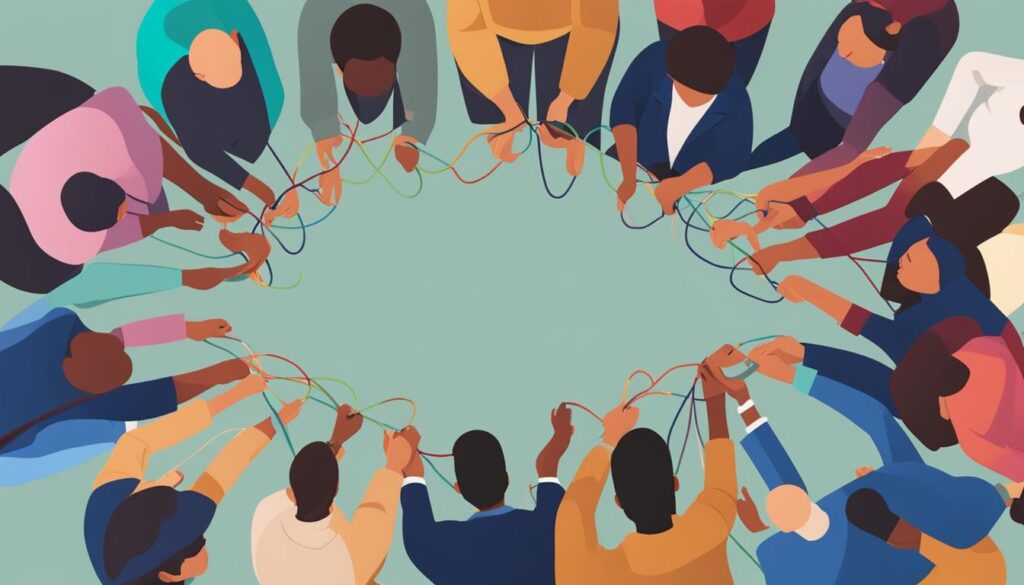Family is the cornerstone of our lives. The relationships and dynamics within our families impact every aspect of our well-being, from our mental health to our sense of identity and purpose. However, navigating these dynamics can be challenging, and conflicts and disagreements can arise, leading to tension and stress in the family unit. This is why it’s essential to foster harmony and growth within the family, promoting open communication, emotional connection, and mutual understanding.
Key Takeaways:
- Family dynamics are complex and impact our overall well-being.
- Promoting harmony and growth requires effective communication, emotional connection, and mutual understanding.
- Understanding the unique dynamics and challenges of different family structures can help build stronger relationships.
- Setting boundaries, providing support, and open communication are critical for nurturing positive parent-child relationships.
- Addressing conflict and resolving issues is essential for promoting understanding and growth within the family unit.
Understanding Family Dynamics
Every family has its own unique set of dynamics, which refers to the roles and relationships between family members. Understanding these relationships is key to fostering healthy interpersonal relationships within the family. Factors such as upbringing, culture, and personal experiences can all influence family dynamics and shape the way that family members interact with each other.
One way to better understand family dynamics is to examine the different roles that family members often take on. Parents, for example, are typically seen as the authority figures and providers in the family, while children often take on more dependent roles. Siblings, on the other hand, may adopt different roles depending on their age, gender, and personalities.
It’s also worth noting that family dynamics can shift and change over time. As children grow older and become more independent, for example, the dynamics between parents and children may evolve into more of a friendship or mentorship. Additionally, major life changes such as divorce, remarriage, or the birth of a new child can also impact family dynamics.
«Families are like branches on a tree. We grow in different directions yet our roots remain as one.»
Ultimately, understanding family dynamics is crucial for building strong, healthy relationships within the family unit. By recognizing the different roles and relationships that exist within the family, we can work to foster communication, respect, and understanding among all family members.

Effective Communication Strategies
Strong family relationships are built upon the foundation of effective communication. It is essential to communicate clearly and openly to foster a healthy family environment. Active listening, assertiveness, and conflict resolution techniques can help to resolve conflicts and misunderstandings.
Active listening involves focusing on what the speaker is saying without distraction. This can help to improve communication and understanding. Assertiveness is the ability to express thoughts, feelings, and needs in a direct and honest way, without disrespecting others. It can help to build mutual respect and trust in family relationships. Conflict resolution techniques, such as active listening, compromising, and finding common ground, can help to peacefully resolve conflicts and prevent further misunderstandings from arising.
Effective communication requires effort from all family members. It is important to create an environment where all family members feel comfortable sharing their thoughts and feelings. Encouraging open communication builds a strong foundation for positive family dynamics.
Examples of Effective Communication Strategies in the Family:
| Communication Strategy | Explanation |
|---|---|
| Active Listening | Listen attentively to the family member speaking. Ask clarifying questions and provide feedback to ensure understanding. |
| Assertiveness | Express thoughts and feelings honestly and respectfully, and in a way that clearly communicates expectations and boundaries. |
| Collaboration | Work together to find a solution that meets the needs of all family members. Identify areas of agreement and common ground. |

Building Strong Bonds
Spending quality time with family members is a key factor in building strong bonds and fostering a deeper connection within the family unit. Whether it’s engaging in shared experiences such as vacations, game nights, or family dinners, setting time aside for these activities can have a significant impact on the overall health and happiness of the family.
It’s important to also focus on fostering emotional connections, through listening, empathy, and support. Encouraging open communication and showing appreciation for each other can create a positive and supportive environment for all family members.

Creating rituals and traditions that are special to the family is another way to build strong bonds and honor family values. This can be anything from a weekly family movie night to a yearly family vacation or holiday tradition.
By prioritizing quality time and emotional connection, families can strengthen their bonds and create a supportive foundation for growth and happiness.
Nurturing Positive Parent-Child Relationships
The relationship between parents and children is a crucial part of the family dynamic. Building a positive and supportive relationship with your child begins with setting healthy boundaries and demonstrating your love and care for them. Providing support is also integral and can involve helping with homework, attending extracurricular activities, or simply being present and available to talk. Open communication is key to fostering understanding and trust between parents and children. Encouraging your child to express their thoughts and feelings promotes a sense of validation and can strengthen your bond.
«My parents always made an effort to spend time with me and listen to my concerns. Those moments made me feel seen and heard, which brought us closer together.» — Sarah Parker, mother of two
As children grow and develop, parenting styles should also adjust. Demonstrate your support for your child’s independence while maintaining your role as a reliable source of guidance. By working together and creating a loving and supportive environment, positive parent-child relationships can thrive.

Sibling Dynamics and Conflict Resolution
Sibling dynamics are an integral part of family relationships but can often be complicated, leading to conflicts and rivalries.
It is crucial to address these issues to promote healthy sibling relationships and a harmonious family environment.

Effective conflict resolution strategies can help siblings work through their issues and strengthen their bonds. Active listening, empathy, and compromise can prevent small disagreements from turning into long-standing conflicts.
«Sibling relationships are complicated. All family relationships are. Look at Hamlet.» — Maurice Saatchi
Encouraging siblings to share their feelings, experiences, and perspectives can promote understanding and empathy. Recognizing and addressing any underlying issues such as jealousy, resentment, or competition can also help resolve conflicts and promote healthy sibling dynamics.
Acknowledging each sibling’s individuality, encouraging their unique strengths and interests can foster an environment of mutual respect and support, promoting stronger and healthier family relationships.
Blended Family Dynamics
In today’s society, blended families are becoming increasingly common. Blended families are formed when parents with children from previous relationships join together to create a new family unit. This unique family dynamic brings with it its own set of challenges and opportunities, including navigating new relationships, integrating step-parents and step-siblings, and promoting harmony.
«A blended family is not a broken family but merely a family that was re-arranged to better fit together. It’s like a puzzle where two different families are put together to form a new one.»
One of the biggest challenges faced by blended families is integrating step-parents and step-siblings. Children may resent their new step-parent, and may feel like they are being replaced by new step-siblings. It is important to give children enough time to adjust to the new family dynamic, and to acknowledge and address any feelings of jealousy or resentment they may have.
Effective communication is also vital in blended families, as each member of the family brings their own unique backgrounds and experiences. Open and honest communication can help to build trust and foster strong relationships.
| Challenges | Solutions | |
|---|---|---|
| Integrating Step-Parents | Resentment from children, feeling replaced by new step-parent | Give children enough time to adjust, acknowledge and address feelings of jealousy or resentment, foster open communication |
| Integrating Step-Siblings | Sibling rivalry, feeling like they are competing for attention or resources | Encourage shared experiences, foster positive relationships through open communication, set clear boundaries and expectations |
| Adjusting to New Family Roles | Difficulty adjusting to new family roles and dynamics | Be patient with the adjustment process, encourage open communication, seek support from family therapists or counselors as needed |
Blended families can be incredibly rewarding, providing opportunities for new experiences and close-knit relationships. With time, patience, and effective communication, blended families can successfully navigate the unique challenges and create a harmonious and loving family unit.

Managing Generational Differences
The modern family is made up of diverse generations with different life experiences, values, and communication styles. Understanding these generational differences is essential for promoting harmony within the family unit.
Older generations may have grown up in a traditional environment that values respect for authority and manners. Younger generations, in contrast, may prioritize independence, self-expression, and inclusivity. These differences can cause misunderstandings and conflicts if left unaddressed.
To bridge the gap, families can use effective communication strategies such as active listening, respectful dialogue, and empathy. Encouraging intergenerational dialogue and sharing positive experiences can also foster mutual understanding and respect.

It is also essential to recognize and respect the individuality of each family member. Avoid making assumptions based on age and cultural background, and seek to celebrate and appreciate differences.
“In today’s fast-paced world, communication is more important than ever. Understanding our generational differences is one key to forging productive relationships and achieving harmony within families.” — Lisa Stone, Family Therapist
Balancing Work and Family Life
The delicate balance between work and family life can be a challenge for many. Between tight deadlines and multiple demands at home, it can be challenging to create a healthy work-life balance. Fortunately, there are strategies that can help.
- Time management. Prioritize your schedule to make time for both work and family obligations, and stick to it. Use tools such as calendars and to-do lists to manage your time effectively.
- Set family priorities. Decide what is most important to you and your family and make sure those priorities are reflected in your schedule and daily routine.
- Create a supportive environment. Communicate with your employer, co-workers, and family members to create a supportive environment that accommodates the needs of both work and family.
Remember, it’s important to prioritize both work and family, and to take breaks when needed to recharge and maintain balance. With some careful planning and a focus on priorities, it’s possible to create a healthy work-life balance that benefits both your career and your family life.

Addressing Conflict and Resolving Issues
Family disputes and conflicts are inevitable, but they don’t have to damage relationships. Conflict resolution is an essential part of maintaining healthy family dynamics. Effective problem-solving techniques can help foster understanding, growth, and improved relationships.
One critical aspect of addressing conflicts is to identify the root cause of the issue. Often, apparent disagreements mask deeper-seated problems that need to be resolved. Active listening is a vital tool in conflict resolution. Encourage family members to express their perspectives without judgment or interruption.
Another effective strategy for resolving conflicts is to establish ground rules for communication. These could include approaches to active listening, managing emotions, and communicating respectfully. Once ground rules are established, families should make a concerted effort to put them into action during conversations.
Family meetings are a valuable tool for resolving conflicts and promoting healthy communication. During these meetings, family members can discuss issues that arise, set common goals, and work towards solutions together. Open communication is essential in family meetings, and everyone should be given the chance to express their thoughts and feelings.
Conflict Resolution Techniques
The following techniques can help resolve conflicts and promote healthy relationships within the family:
| Technique | Description |
|---|---|
| Active Listening | Pay attention and reflect on what the other person is saying to ensure that everyone feels heard and understood. |
| Respectful Communication | Communicate in a respectful tone, even when conflicts arise. |
| Empathy | Try to understand the other person’s point of view and empathize with their feelings. |
| Collaboration | Work together to find a solution that benefits everyone involved. |
| Problem-solving | Brainstorm solutions to the issue, evaluate the pros and cons of each option, and agree on a course of action. |
The key to effective conflict resolution is to recognize that disagreements and conflicts are a normal part of family dynamics. Open lines of communication, empathy, respect, and problem-solving can help family members navigate these issues successfully.

Strengthening Family Values and Traditions
Families are the foundation of society, and family values and traditions play a crucial role in shaping the values and beliefs of future generations. These values and traditions can provide a sense of identity and belonging, and help promote a strong, cohesive family unit. It is important to pass down these values and traditions through generations to maintain family ties and foster harmonious relationships.
One way to strengthen family values is by spending quality time together. Creating a regular family tradition such as a weekly game night or going on a yearly family vacation can help foster a sense of togetherness and create lasting memories.
Another way to promote family values is by establishing family rituals. These can include anything from holiday traditions to daily routines, such as family dinners or bedtime stories. These rituals create a sense of continuity and connection, and can help instill a strong sense of identity and belonging in children.
It is also important to pass on cultural heritage and traditions. This can be done through storytelling, cooking traditional foods, or participating in cultural events and celebrations. These experiences provide a sense of history and identity, and help children connect with their cultural roots and learn to appreciate diversity.
Ultimately, strengthening family values and traditions is about creating a sense of unity and shared purpose within the family unit. By prioritizing quality time, establishing rituals, and passing down cultural heritage, families can create a strong foundation that will endure for generations to come.

Conclusion
In today’s fast-paced world, navigating family dynamics can be challenging. However, fostering harmony and growth within the family unit is essential for building strong bonds and creating a supportive environment. From understanding family dynamics to nurturing positive relationships, effective communication strategies, conflict resolution, creating work-life balance, and passing on family values and traditions, there are many factors to consider.
By implementing the strategies discussed in this article, families can address conflicts, build strong bonds, and promote growth to create a happy and healthy family unit. Remember, building a strong and supportive family takes time, patience, and effort, but the rewards are priceless.
So, take the first step towards creating a harmonious and supportive family environment by implementing the strategies discussed in this article today!
FAQ
What are family dynamics?
Family dynamics refer to the patterns of interactions and relationships within a family. It includes the roles, communication styles, and power dynamics between family members.
Why is understanding family dynamics important?
Understanding family dynamics is essential for fostering healthy relationships and promoting harmony within the family. It helps identify underlying issues, improve communication, and build stronger bonds between family members.
What are some effective communication strategies for family relationships?
Effective communication strategies for family relationships include active listening, expressing emotions assertively, using «I» statements, and practicing empathy and understanding. It also involves open and honest conversations and resolving conflicts peacefully.
How can I build strong bonds within my family?
Building strong bonds within the family can be achieved by spending quality time together, engaging in shared activities and experiences, expressing love and appreciation, and fostering emotional connections through open communication and support.
How can I nurture positive parent-child relationships?
To nurture positive parent-child relationships, it is important to set boundaries, provide emotional support, actively listen to your child, be involved in their lives, and maintain open and honest communication. Showing love, respect, and understanding are also crucial.
What are some strategies for resolving conflicts between siblings?
Strategies for resolving conflicts between siblings include encouraging active listening and empathy, teaching problem-solving skills, promoting fairness and compromise, setting clear boundaries, and fostering a supportive and respectful environment for all family members.
How can blended families promote harmony?
Blended families can promote harmony by fostering open communication, acknowledging and addressing challenges, encouraging step-parents to establish positive relationships with step-children, and creating a sense of unity through shared activities and traditions.
How can generational differences be managed within a family?
Managing generational differences within a family involves practicing empathy and understanding, engaging in open and respectful dialogue, acknowledging and appreciating different perspectives, and finding common ground to bridge the gap between generations.
What are some strategies for balancing work and family life?
Strategies for balancing work and family life include setting priorities, effective time management, establishing a supportive network, delegating responsibilities, practicing self-care, and creating boundaries between work and personal life.
How can conflicts and issues within the family be addressed and resolved?
Conflicts and issues within the family can be addressed and resolved by promoting open communication, active listening, empathy, and compromise. It is important to find common solutions, seek mediation if necessary, and prioritize understanding and growth.
How can family values and traditions be strengthened?
Family values and traditions can be strengthened by engaging in activities that reinforce those values, passing down family stories and traditions from generation to generation, and involving all family members in the decision-making process. It is important to celebrate and cherish the unique heritage and legacy of the family.
